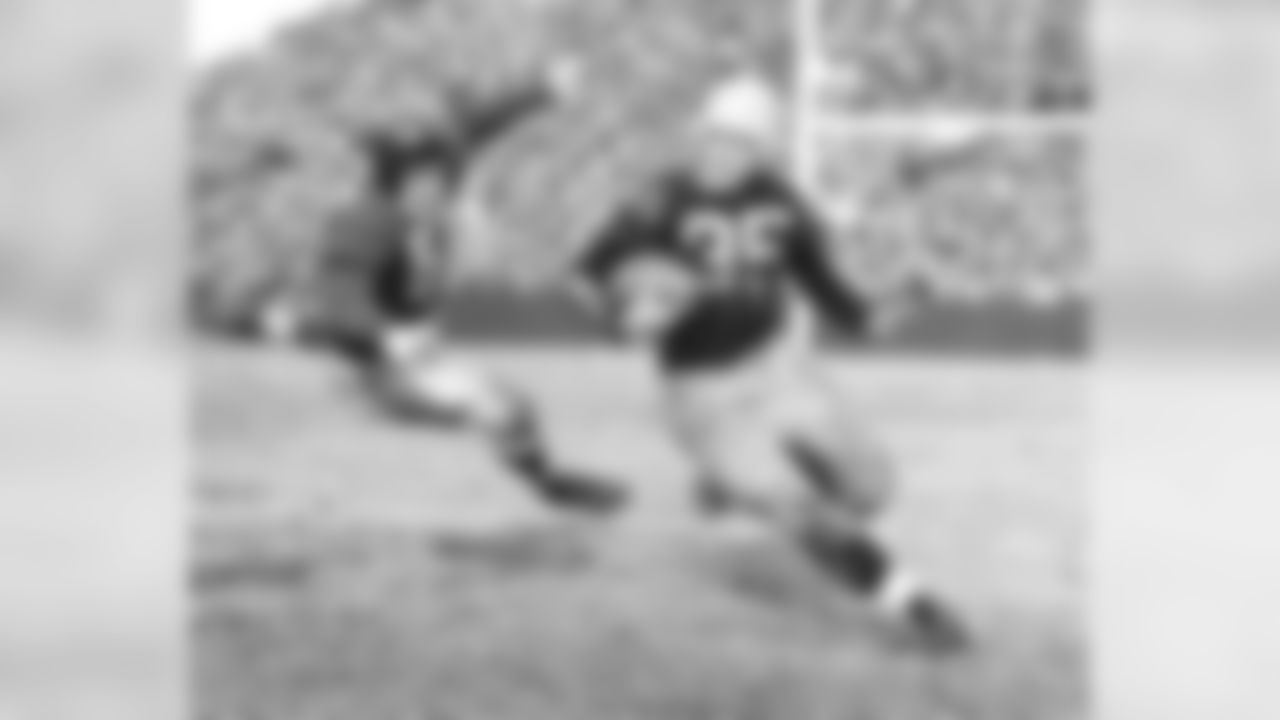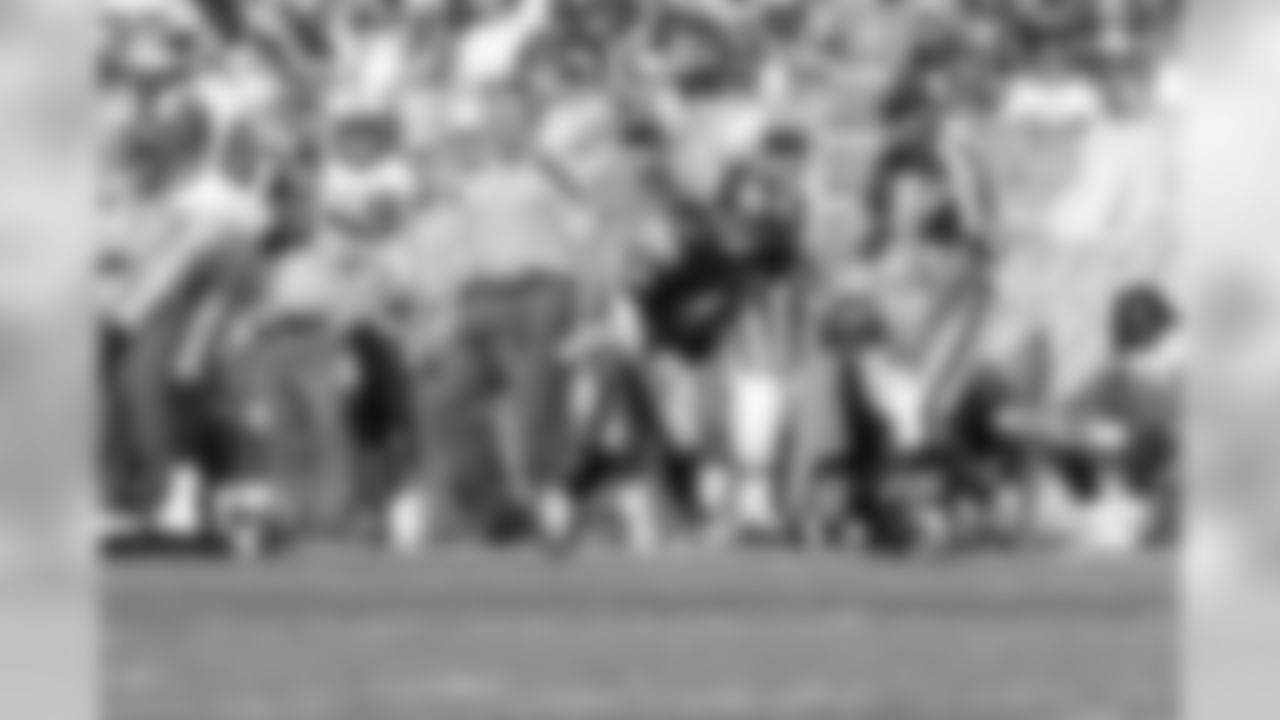The last in a series examining the best of 81 seasons worth of Steelers' draft picks, designated by round. Today's installment looks at the history of Round 1:
1938 – BYRON "WHIZZER" WHITE: Convinced to delay his Rhodes Scholarship to the University of Oxford by the then-outrageous sum of $10,000 to play professional football, White, a single-wing tailback, led the NFL in rushing attempts (152), yards (567), and yards from scrimmage (655), but the Steelers finished 2-9. White's true impact came as the 12th-longest serving justice in U.S. Supreme Court history. Appointed to the court by President John F. Kennedy in 1962, White retired in 1993. "Of all the athletes I have known in my lifetime, I'd have to say Whizzer White came as close to anyone to giving 100 percent of himself when he was in competition," said Rooney.
1942 – BILL DUDLEY: Since the NFL-AFL merger in 1970, the Pittsburgh Steelers have rushed for more yards than any other team in the league, and their edge is not insubstantial. So, who is the last Steelers back to lead the NFL in rushing? Wrong – it was Bill Dudley, a tailback in the team's single-wing offense during his era. Dudley led the NFL in rushing twice during his time with the Steelers – first as a rookie with 696 yards on 162 attempts, and then his 1946 season was an all-timer. In 1946, Dudley led the NFL in rushing (604 yards on 146 attempts), but he also led the NFL in punt returns (385 yards on 27 returns for a 14.3 average), and he led the NFL in interceptions (10 that he returned for 242 yards), and he led the NFL in fumble recoveries (seven). He also served as the team's punter with a 40.2 average, and he passed for 438 yards and two touchdowns. Hall of Fame, Class of 1966.
1957 – LEN DAWSON: Back in this era, the Steelers did a better job of drafting than developing. In 1955, they had cut a quarterback they picked on the ninth-round named John Unitas; and in 1957, they would draft Dawson but cut him after three years and only 17 pass attempts. Unitas was inducted into the Hall of Fame in 1979. Dawson was inducted in 1987.
1969 – JOE GREENE: The greatest player in franchise history. The most significant player in franchise history. The only player deserving to be on the Steelers' Mount Rushmore, along with Art Rooney Sr., Dan Rooney, and Chuck Noll. Greene was the NFL Defensive Rookie of the Year, a two-time winner of the NFL Defensive Player of the Year Award (1972 and 1974), and a five-time first-team All-Pro. Hall of Fame, Class of 1987. Four Super Bowl rings. (Pictured above)
1970 – TERRY BRADSHAW: If you're a guy who likes his quarterback to come up big in critical games, Bradshaw is your guy. He was 14-5 as a starter in the playoffs, 4-0 in the Super Bowl. His postseason passer rating was 83.0, and his 8.41 yards/attempt is the highest in NFL history among quarterbacks who have a comparable number of playoff starts. Bradshaw wouldn't help you win your fantasy league, but he forced you to build a bigger trophy case. Hall of Fame, Class of 1989. Four Super Bowl rings.
**
Take a look at the 1st round draft picks throughout Steelers history.

1938 BYRON WHIZZER WHITE: Convinced to delay his Rhodes Scholarship to the University of Oxford by the then-outrageous sum of $10,000 to play professional football, White, a single-wing tailback, led the NFL in rushing attempts (152), yards (567), and yards from scrimmage (655), but the Steelers finished 2-9. Whites true impact came as the 12th-longest serving justice in U.S. Supreme Court history. Appointed to the court by President John F. Kennedy in 1962, White retired in 1993. Of all the athletes I have known in my lifetime, I'd have to say Whizzer White came as close to anyone to giving 100 percent of himself when he was in competition, said Rooney.

1942 BILL DUDLEY: Since the NFL-AFL merger in 1970, the Pittsburgh Steelers have rushed for more yards than any other team in the league, and their edge is not insubstantial. So, who is the last Steelers back to lead the NFL in rushing? Wrong, it was Bill Dudley, a tailback in the teams single-wing offense during his era. Dudley led the NFL in rushing twice during his time with the Steelers, first as a rookie with 696 yards on 162 attempts, and then his 1946 season was an all-timer. In 1946, Dudley led the NFL in rushing (604 yards on 146 attempts), but he also led the NFL in punt returns (385 yards on 27 returns for a 14.3 average), and he led the NFL in interceptions (10 that he returned for 242 yards), and he led the NFL in fumble recoveries (seven). He also served as the teams punter with a 40.2 average, and he passed for 438 yards and two touchdowns. Hall of Fame, Class of 1966.

1957 LEN DAWSON: Back in this era, the Steelers did a better job of drafting than developing. In 1955, they had cut a quarterback they picked on the ninth-round named John Unitas; and in 1957, they would draft Dawson but cut him after three years and only 17 pass attempts. Unitas was inducted into the Hall of Fame in 1979. Dawson was inducted in 1987.

1969 JOE GREENE: The greatest player in franchise history. The most significant player in franchise history. The only player deserving to be on the Steelers Mount Rushmore, along with Art Rooney Sr., Dan Rooney, and Chuck Noll. Greene was the NFL Defensive Rookie of the Year, a two-time winner of the NFL Defensive Player of the Year Award (1972 and 1974), and a five-time first-team All-Pro. Hall of Fame, Class of 1987. Four Super Bowl rings.

1970 TERRY BRADSHAW: If youre a guy who likes his quarterback to come up big in critical games, Bradshaw is your guy. He was 14-5 as a starter in the playoffs, 4-0 in the Super Bowl. His postseason passer rating was 83.0, and his 8.41 yards/attempt is the highest in NFL history among quarterbacks who have a comparable number of playoff starts. Bradshaw wouldnt help you win your fantasy league, but he forced you to build a bigger trophy case. Hall of Fame, Class of 1989. Four Super Bowl rings.

1972 FRANCO HARRIS: In terms of coming up big in critical games, Harris is the running back version of Terry Bradshaw. In 19 playoff games, Harris carried 400 times for 1,556 yards (3.9 average) with 16 touchdowns, while also catching 51 passes for 504 more yards and another touchdown. Harris rushed for four touchdowns in four Super Bowl wins. Harris is second in all-time postseason rushing yards to Emmitt Smith (1,556-1,586) but when receptions are added in, Harris leads Smith in yards from scrimmage (2,060-1,928). Hall of Fame, Class of 1990. Four Super Bowl rings.

1974 LYNN SWANN: Quality over quantity might be the simplest way to characterize Swanns career. His 907 receiving yards in 16 playoff games is more than he ever amassed over a whole regular season, and he also averaged 18.9 yards per catch in the postseason to go along with nine touchdowns. In 1975, Swann led the NFL with 11 touchdown receptions on only 49 catches, and then he capped that season by being voted the MVP of Super Bowl X. Hall of Fame, Class of 2001. Four Super Bowl rings.

1984 LOUIS LIPPS: A playmaking receiver not lucky enough to play with either Terry Bradshaw or Ben Roethlisberger, Lipps led the NFL in punt returns as a rookie and then caught 59 passes for 1,132 yards (19.2 average) in 1985. In his first two seasons with the Steelers, Lipps scored 24 touchdowns receiving and returning.

1987 ROD WOODSON: In terms of cornerbacks who werent afraid to make a tackle, Woodson was the best of his era. In 10 seasons with the Steelers, Woodson was named first-team All-Pro five times and won the NFL Defensive Player of the Year Award in 1993. Woodson finished his career here with 13.5 sacks, 38 interceptions, 16 forced fumbles, and 21 fumble recoveries. He scored six defensive touchdowns, and added another four on returns. Hall of Fame, Class of 2009.

1998 ALAN FANECA: The best guard in franchise history, Faneca started 153 of the 158 games he played in a Steelers uniform. During his career here, Faneca was voted to seven Pro Bowls and was named first-team All-Pro six times. One Super Bowl ring.

2001 CASEY HAMPTON: An underrated leader on Steelers teams that played in three Super Bowls and won two, Hampton was voted to five Pro Bowls. During his 13 seasons, the Steelers run defense was ranked among the NFLs top three 10 times, and it was No. 1 four of those times. Two Super Bowl rings.

2003 TROY POLAMALU: The Steelers secondarys top playmaker during his era, Polamalu has started 130 regular season games, and he has 12 sacks, 32 interceptions, 13 forced fumbles, and six fumble recoveries. He has scored five defensive touchdowns. In the playoffs, Polamalu has three interceptions and one touchdown. He was the 2010 NFL Defensive Player of the Year, and he has been named first-team All-Pro four times. Two Super Bowl rings.

2004 BEN ROETHLISBERGER: His 13-0 record as a rookie stamped him as a winner, and Roethlisberger today is one of only 11 quarterbacks to win multiple Super Bowls as a starting quarterback. His playoff record is 10-4, 2-0 in Super Bowls, and Roethlisberger has completed 60.6 of his postseason passes, with 20 touchdowns and a rating of 83.7. Still writing his history. Two Super Bowl rings.

2005 HEATH MILLER: The best tight end in franchise history, Miller has handled all facets of his position like few others in the NFL throughout his first nine seasons. Miller has started 136 of his 137 career games, and he has contributed 5,273 receiving yards and 40 touchdowns. In 12 postseason games, Miller has 40 catches and four touchdowns. Voted to the Pro Bowl twice. Two Super Bowl rings.
1972 – FRANCO HARRIS:** In terms of coming up big in critical games, Harris is the running back version of Terry Bradshaw. In 19 playoff games, Harris carried 400 times for 1,556 yards (3.9 average) with 16 touchdowns, while also catching 51 passes for 504 more yards and another touchdown. Harris rushed for four touchdowns in four Super Bowl wins. Harris is second in all-time postseason rushing yards to Emmitt Smith (1,556-1,586) but when receptions are added in, Harris leads Smith in yards from scrimmage (2,060-1,928). Hall of Fame, Class of 1990. Four Super Bowl rings.
1974 – LYNN SWANN: Quality over quantity might be the simplest way to characterize Swann's career. His 907 receiving yards in 16 playoff games is more than he ever amassed over a whole regular season, and he also averaged 18.9 yards per catch in the postseason to go along with nine touchdowns. In 1975, Swann led the NFL with 11 touchdown receptions on only 49 catches, and then he capped that season by being voted the MVP of Super Bowl X. Hall of Fame, Class of 2001. Four Super Bowl rings.
1984 – LOUIS LIPPS: A playmaking receiver not lucky enough to play with either Terry Bradshaw or Ben Roethlisberger, Lipps led the NFL in punt returns as a rookie and then caught 59 passes for 1,132 yards (19.2 average) in 1985. In his first two seasons with the Steelers, Lipps scored 24 touchdowns receiving and returning.
1987 – ROD WOODSON: In terms of cornerbacks who weren't afraid to make a tackle, Woodson was the best of his era. In 10 seasons with the Steelers, Woodson was named first-team All-Pro five times and won the NFL Defensive Player of the Year Award in 1993. Woodson finished his career here with 13.5 sacks, 38 interceptions, 16 forced fumbles, and 21 fumble recoveries. He scored six defensive touchdowns, and added another four on returns. Hall of Fame, Class of 2009.
1998 – ALAN FANECA: The best guard in franchise history, Faneca started 153 of the 158 games he played in a Steelers uniform. During his career here, Faneca was voted to seven Pro Bowls and was named first-team All-Pro six times. One Super Bowl ring.
2001 – CASEY HAMPTON: An underrated leader on Steelers teams that played in three Super Bowls and won two, Hampton was voted to five Pro Bowls. During his 13 seasons, the Steelers run defense was ranked among the NFL's top three 10 times, and it was No. 1 four of those times. Two Super Bowl rings.
2003 – TROY POLAMALU: The Steelers' secondary's top playmaker during his era, Polamalu has started 142 regular season games, and he has 12 sacks, 32 interceptions, 13 forced fumbles, and seven fumble recoveries. He has scored five defensive touchdowns. In the playoffs, Polamalu has three interceptions and one touchdown. He was the 2010 NFL Defensive Player of the Year, and he has been named first-team All-Pro four times. Two Super Bowl rings.
2004 – BEN ROETHLISBERGER: His 13-0 record as a rookie stamped him as a winner, and Roethlisberger today is one of only 11 quarterbacks to win multiple Super Bowls as a starting quarterback. His playoff record is 10-5, 2-1 in Super Bowls, and Roethlisberger has completed 61.5 percent of his postseason passes, with 21 touchdowns and a rating of 83.3. Still writing his history. Two Super Bowl rings.
2005 – HEATH MILLER: The best tight end in franchise history, Miller has handled all facets of his position like few others in the NFL throughout his first nine seasons. Miller has started 152 of his 153 career games, and he has contributed 6,034 receiving yards and 43 touchdowns. In 13 postseason games, Miller has 46 catches and four touchdowns. Voted to the Pro Bowl twice. Two Super Bowl rings.
















